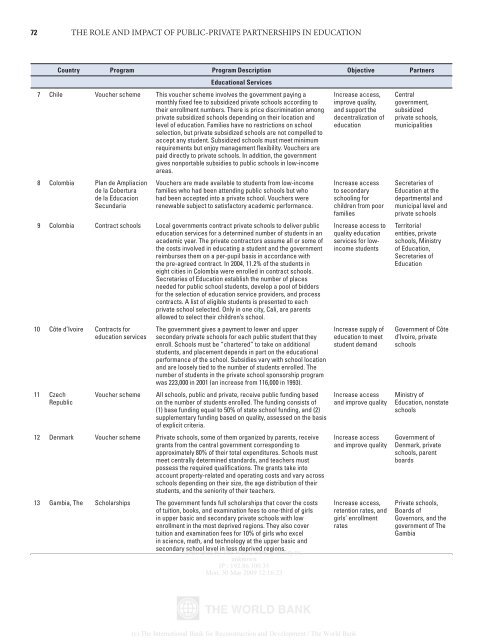The Role and Impact of Public-Private Partnerships in Education
The Role and Impact of Public-Private Partnerships in Education
The Role and Impact of Public-Private Partnerships in Education
Create successful ePaper yourself
Turn your PDF publications into a flip-book with our unique Google optimized e-Paper software.
72 THE ROLE AND IMPACT OF PUBLIC-PRIVATE PARTNERSHIPS IN EDUCATION<br />
Country Program Program Description Objective Partners<br />
<strong>Education</strong>al Services<br />
7 Chile Voucher scheme This voucher scheme <strong>in</strong>volves the government pay<strong>in</strong>g a<br />
monthly fixed fee to subsidized private schools accord<strong>in</strong>g to<br />
their enrollment numbers. <strong>The</strong>re is price discrim<strong>in</strong>ation among<br />
private subsidized schools depend<strong>in</strong>g on their location <strong>and</strong><br />
level <strong>of</strong> education. Families have no restrictions on school<br />
selection, but private subsidized schools are not compelled to<br />
accept any student. Subsidized schools must meet m<strong>in</strong>imum<br />
requirements but enjoy management flexibility. Vouchers are<br />
paid directly to private schools. In addition, the government<br />
gives nonportable subsidies to public schools <strong>in</strong> low-<strong>in</strong>come<br />
areas.<br />
8 Colombia Plan de Ampliacion<br />
de la Cobertura<br />
de la Educacion<br />
Secundaria<br />
Vouchers are made available to students from low-<strong>in</strong>come<br />
families who had been attend<strong>in</strong>g public schools but who<br />
had been accepted <strong>in</strong>to a private school. Vouchers were<br />
renewable subject to satisfactory academic performance.<br />
9 Colombia Contract schools Local governments contract private schools to deliver public<br />
education services for a determ<strong>in</strong>ed number <strong>of</strong> students <strong>in</strong> an<br />
academic year. <strong>The</strong> private contractors assume all or some <strong>of</strong><br />
the costs <strong>in</strong>volved <strong>in</strong> educat<strong>in</strong>g a student <strong>and</strong> the government<br />
reimburses them on a per-pupil basis <strong>in</strong> accordance with<br />
the pre-agreed contract. In 2004, 11.2% <strong>of</strong> the students <strong>in</strong><br />
eight cities <strong>in</strong> Colombia were enrolled <strong>in</strong> contract schools.<br />
Secretaries <strong>of</strong> <strong>Education</strong> establish the number <strong>of</strong> places<br />
needed for public school students, develop a pool <strong>of</strong> bidders<br />
for the selection <strong>of</strong> education service providers, <strong>and</strong> process<br />
contracts. A list <strong>of</strong> eligible students is presented to each<br />
private school selected. Only <strong>in</strong> one city, Cali, are parents<br />
allowed to select their children’s school.<br />
10 Côte d’Ivoire Contracts for<br />
education services<br />
11 Czech<br />
Republic<br />
Voucher scheme<br />
<strong>The</strong> government gives a payment to lower <strong>and</strong> upper<br />
secondary private schools for each public student that they<br />
enroll. Schools must be “chartered” to take on additional<br />
students, <strong>and</strong> placement depends <strong>in</strong> part on the educational<br />
performance <strong>of</strong> the school. Subsidies vary with school location<br />
<strong>and</strong> are loosely tied to the number <strong>of</strong> students enrolled. <strong>The</strong><br />
number <strong>of</strong> students <strong>in</strong> the private school sponsorship program<br />
was 223,000 <strong>in</strong> 2001 (an <strong>in</strong>crease from 116,000 <strong>in</strong> 1993).<br />
All schools, public <strong>and</strong> private, receive public fund<strong>in</strong>g based<br />
on the number <strong>of</strong> students enrolled. <strong>The</strong> fund<strong>in</strong>g consists <strong>of</strong><br />
(1) base fund<strong>in</strong>g equal to 50% <strong>of</strong> state school fund<strong>in</strong>g, <strong>and</strong> (2)<br />
supplementary fund<strong>in</strong>g based on quality, assessed on the basis<br />
<strong>of</strong> explicit criteria.<br />
12 Denmark Voucher scheme <strong>Private</strong> schools, some <strong>of</strong> them organized by parents, receive<br />
grants from the central government correspond<strong>in</strong>g to<br />
approximately 80% <strong>of</strong> their total expenditures. Schools must<br />
meet centrally determ<strong>in</strong>ed st<strong>and</strong>ards, <strong>and</strong> teachers must<br />
possess the required qualifications. <strong>The</strong> grants take <strong>in</strong>to<br />
account property-related <strong>and</strong> operat<strong>in</strong>g costs <strong>and</strong> vary across<br />
schools depend<strong>in</strong>g on their size, the age distribution <strong>of</strong> their<br />
students, <strong>and</strong> the seniority <strong>of</strong> their teachers.<br />
13 Gambia, <strong>The</strong> Scholarships <strong>The</strong> government funds full scholarships that cover the costs<br />
<strong>of</strong> tuition, books, <strong>and</strong> exam<strong>in</strong>ation fees to one-third <strong>of</strong> girls<br />
<strong>in</strong> upper basic <strong>and</strong> secondary private schools with low<br />
enrollment <strong>in</strong> the most deprived regions. <strong>The</strong>y also cover<br />
tuition <strong>and</strong> exam<strong>in</strong>ation fees for 10% <strong>of</strong> girls who excel<br />
<strong>in</strong> science, math, <strong>and</strong> technology at the upper basic <strong>and</strong><br />
secondary school level <strong>in</strong> less deprived regions.<br />
Delivered by <strong>The</strong> World Bank e-library to:<br />
unknown<br />
IP : 192.86.100.35<br />
Mon, 30 Mar 2009 12:16:23<br />
Increase access,<br />
improve quality,<br />
<strong>and</strong> support the<br />
decentralization <strong>of</strong><br />
education<br />
Increase access<br />
to secondary<br />
school<strong>in</strong>g for<br />
children from poor<br />
families<br />
Increase access to<br />
quality education<br />
services for low<strong>in</strong>come<br />
students<br />
Increase supply <strong>of</strong><br />
education to meet<br />
student dem<strong>and</strong><br />
Increase access<br />
<strong>and</strong> improve quality<br />
Increase access<br />
<strong>and</strong> improve quality<br />
Increase access,<br />
retention rates, <strong>and</strong><br />
girls’ enrollment<br />
rates<br />
Central<br />
government,<br />
subsidized<br />
private schools,<br />
municipalities<br />
Secretaries <strong>of</strong><br />
<strong>Education</strong> at the<br />
departmental <strong>and</strong><br />
municipal level <strong>and</strong><br />
private schools<br />
Territorial<br />
entities, private<br />
schools, M<strong>in</strong>istry<br />
<strong>of</strong> <strong>Education</strong>,<br />
Secretaries <strong>of</strong><br />
<strong>Education</strong><br />
Government <strong>of</strong> Côte<br />
d’Ivoire, private<br />
schools<br />
M<strong>in</strong>istry <strong>of</strong><br />
<strong>Education</strong>, nonstate<br />
schools<br />
Government <strong>of</strong><br />
Denmark, private<br />
schools, parent<br />
boards<br />
<strong>Private</strong> schools,<br />
Boards <strong>of</strong><br />
Governors, <strong>and</strong> the<br />
government <strong>of</strong> <strong>The</strong><br />
Gambia<br />
(c) <strong>The</strong> International Bank for Reconstruction <strong>and</strong> Development / <strong>The</strong> World Bank
















